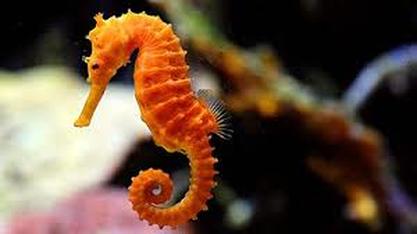Amazing Seahorses
Imagine yourself as a copepod floating in the ocean seagrass among clown fish, puffers, and dozens of other sea creatures, when you realize you’re being hunted by a delicate slow poke seahorse who only swims five feet per hour. Copepods can escape from their prey very fast, so fast that the reach speeds that are the same as a human jumping 3000 miles per hour. Do you think that would be fast enough to escape a hungry seahorse? Not quite!

Best Ocean Predator
A seahorse’s favorite food to munch on is a copepod. Copepods are part of an animal group called crustaceans. Copepods are not only fast but they can sense vibrations from an oncoming predator and when they do sense those vibrations they get out of there speedy quick but seahorses can still catch those speedy copepods. Here’s why. Seahorses have a very unique shaped head with a feature above their nose that helps them make no waves and vibrations in the water when striking and then they suck up the copepod. This happens so fast that you cannot even see it without a very slowed down camera. If the copepods do sense the seahorse and try to bolt, the seahorse starts pivot feeding. Pivot feeding is where seahorse rotates their snout at high speed and then sucks in the copepod. This makes the seahorse one of the most successful predators in the ocean. I bet you thought it was sharks? Sharks are only successful at catching their prey fifty-five percent of the time. Seahorses are successful in catching their prey ninety percent of the time. Seahorses have to constantly eat to stay alive because food quickly passes through their simple digestive system. They have no teeth and no stomach. Since seahorses do not have teeth they have to suck in their prey and swallow it whole.
Courtship
We talked about seahorses unique ability to catch their prey very fast and how successful they are. Another unique thing about the seahorse is that the male gets pregnant, carries the eggs and gives birth instead of the female. Seahorse males and females have a courtship. This is like dating. Before
they breed they court for several days by dancing in sync for eight hours and swimming side by side while holding the same strip of seagrass with their tales. During this time they sometimes change color.
Seahorse Habitats
Seahorses are usually found in shallow, tropical, and mild saltwater. They live in secure areas such as estuaries, coral reefs, and seagrass beds. Seahorse species are found in the Pacific and the Atlantic waters all the way from North America to South America. Species are also found in the European and Mediterranean waters.
If you like seahorses as much as I do, go down to the Batiquitos or San Elijo Lagoon and you might see them. Seahorses, as slow and delicate as they are, are quite unique and skilled at catching prey. Some seahorse species are endangered because in some countries they are hunted by humans to eat and they are also hunted for aquariums. Seahorse does not do well or live very long in an aquarium. I saw one in a tank when I recently went to a seafood restaurant for dinner. I thought it was very neat to see them but now after reading more about them, I feel sorry for the ones in the fish tank. Pollution is another reason for the threat to seahorses. We should all be doing our part to keep nature clean. I am going to the beach clean-up soon. Ask me how you can join in on it! I guarantee that you learned something about seahorses that you never knew before. Seahorses are not only cute but very interesting and I hope my article was too.